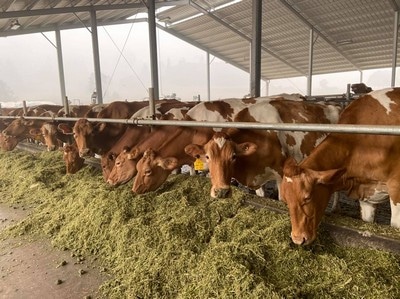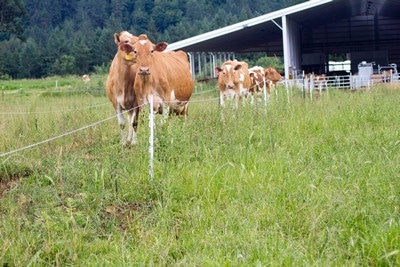A feature article in our 2020 Fall issue, “Abiqua Acres – Mann’s Guernsey Dairy,” was written by Kathleen O’Keefe.

There’s plenty to love about dairying in the western foothills of the Cascade Mountains: the ability to pasture from March to November, the local consumer base, the natural beauty. But there’s one thing that is much less desirable – the annual wildfire season. As we all know from watching the news over the past weeks, the Western United States has experienced a record wildfire season. Over five million acres have burned so far in California, Washington, and Oregon, and many of those fires are still burning.
Abiqua Acres, located in Silverton, Oregon on the edge of the Willamette Valley, survived a close-up experience with this fierce fire season. The operation, consisting of nearly 100 acres, is home to a 100% registered Guernsey herd owned by Alan & Barbara Mann and Ben & Darleen Sichley. Registered Guernseys have been grazing the farm’s pastures since 1952, when Alan’s parents, Paul & Delores Mann, purchased their first. Descendants of that original cow – 18 generations later – still make up part of the 95-cow herd today.
Always a family-run operation, Alan & Barbara purchased the farm in 1985, and their daughter Darleen and her husband Ben joined as partners in 2008. The two couples along with Ben and Darleen’s sons, Mason (9), Nolan (6), Clinton (2) make up the labor force on the farm, with an additional Sichley on the way this fall! They utilize their acreage mainly for rotational grazing for the herd, and purchase corn sileage locally and alfalfa hay from eastern Oregon.
 A number of years ago, the family realized their old, original parlor needed replacement, and so they had to make a decision. Building a new, bigger parlor meant having to hire employees, which was something they were reluctant to do having always been a family-run, family-labor farm. So they studied the possibility of moving to a robotic milking situation. “It took a long time to research. We looked at a lot of facilities in the US and Canada, but that was a big part of our success when we built the new barn and transitioned the herd,” notes Darleen. The new milking facility was completed in 2017 and houses the herd and two DeLaval VMS units in a free flow barn.
A number of years ago, the family realized their old, original parlor needed replacement, and so they had to make a decision. Building a new, bigger parlor meant having to hire employees, which was something they were reluctant to do having always been a family-run, family-labor farm. So they studied the possibility of moving to a robotic milking situation. “It took a long time to research. We looked at a lot of facilities in the US and Canada, but that was a big part of our success when we built the new barn and transitioned the herd,” notes Darleen. The new milking facility was completed in 2017 and houses the herd and two DeLaval VMS units in a free flow barn.
Darleen elaborates on the change and transition in the operation, “Our current RHA is 16,330M 763F and 570P. We’ve seen a dip the RHA and it reflects moving into our new facility. Not that the transition hasn’t gone well – we are happy with our daily averages 2.7 milking and 52lbs. Our new facility with capacity for 120 cows allows us to hold onto all of our young cows, including those that we probably would have culled in the past for production. We are basically only culling right now for breeding or major production issues. As a closed herd looking to grow naturally, or if milk prices will ever improve, to allow us to purchase in some embryos. It also reflects the learning curve with robotics and how nutritional changes play a bigger part as we transition again from cannery waste corn silage to field corn. But we are very happy with our decision to go robotic!”
The family has always emphasized breeding a commercially productive registered herd with moderate-sized cows that breed back and last. Abiqua Acres Presige Jesusita EX-92 had lifetime totals of 186,363M 8,263F and 6,604P over 10 lactations. She exemplified the goals of their breeding program. She stayed in the herd until she was 17, and was a real herd favorite. Her son, Abiqua Acres Levi’s Jaeger, is in AI at Select Sires and will see his first daughters calve in this fall.
Abiqua Acres Goliath Velma EX-90 was another favorite who stayed in the herd until she was 16-years-old. She had multiple sons in AI: Banger Verdict, Alstar VIP and stood second on the national Guernsey living lifetime list for several years, as well as being the top NM$ cow, with a lifetime totals of 234,933M 12,064F and 7,868P.

One more cows family that has been influential is the ‘S’ family. One of Alan’s first purchases in 1967 from Frances Hertel was a calf named Vanher Banker Snooks. There have been 171 direct female descendants with no ETs. The ‘S’ family has accounted for over 20 cows that have surpassed 100,000 lbs of milk, totaling 6,408,681 lbs of milk over the lifetime of this family. Notable individuals include siblings from Abiqua Acres Lords Sprinkles VG-86: a son at Genex, Abiqua Acres Grumpy Sergeant, and his sister Abiqua Acres Faros Speranza VG-89, who produced over 130,000M lifetime. Her son Abiqua Acres Geo Sputnik was also placed in AI.
They’ve currently scaled back their efforts in the show ring with Ben & Darleen having young kids at home, but always enjoyed exhibiting at the Oregon State Fair in nearby Salem, and at the Western National Guernsey Show in Puyallup, WA. Abiqua Acres Aaron’s Meara EX-93 put together an impressive show ring record and was a three-time Grand Champion at the Oregon State Fair. The family has always dedicated time to breed organizations. Alan Mann just finished serving eight years on the American Guernsey Association Board of Directors this past summer.
Darleen has a real social media presence and a large public outreach effort for the farm. “I love interacting with the public especially through farm tours. I never seem to turn down a group, but especially enjoy the Adopt a Farmer program which focuses on middle school age kids. This past school year and this year will be different with social distancing needs. But I’ve been having fun jumping into virtual tours. In addition, being active and present in social media is so very important,” she explains. Known on Instagram and Facebook as @guernseydairymama, she also contributes regularly to Hoard’s Dairyman.
But it was through her social media channels that most people saw the shocking images of orange skies and air thick with smoke taken from the dairy in September. The fire began as a lightning strike and as it grew in size, it was named the Beachie Creek fire. “When it began, the Beachie Creek fire was 60 miles away from our farm,” says Darleen. “But on Sept. 7, a hard wind blew from the east, which never happens here. The Beachie Creek fire joined up with two other fires and moved 50 miles westward in one day.”
 The dairy was suddenly placed under level 3 evacuation orders, which means immediate evacuation. “We were allowed to stay at the farm to care for the cattle. The new facility is all steel and concrete, and had a cleared area around it, so we took our chances. The youngstock were in older wooden buildings, so that was a bit more risk, but we had a plan to get them and the nursery calves in trailers to evacuate,” Darleen recounts. “My husband and my father are both volunteer firefighters, so they kept a close eye on the situation. The fire was finally stopped when it was just 4 miles from our farm.”
The dairy was suddenly placed under level 3 evacuation orders, which means immediate evacuation. “We were allowed to stay at the farm to care for the cattle. The new facility is all steel and concrete, and had a cleared area around it, so we took our chances. The youngstock were in older wooden buildings, so that was a bit more risk, but we had a plan to get them and the nursery calves in trailers to evacuate,” Darleen recounts. “My husband and my father are both volunteer firefighters, so they kept a close eye on the situation. The fire was finally stopped when it was just 4 miles from our farm.”
Once the fire was no longer the immediate threat, the smoke became the larger obstacle.
“The air quality was just terrible – the worst in the country – but the cows hardly missed a beat. We were without electricity for about a week. On the second day without electricity, one of our backup generators failed. We lost a few hours’ worth of milking, but other than that the cows have been doing fine. Nothing much has changed for the cows other than we haven’t been able to turn them out onto the pasture due to fire safety concerns,” notes Darleen.
Abiqua Acres purchases nearly all of the feed inputs for its herd. On most days, the milking cows are let out onto a pasture located near the dairy barn to graze and exercise.
“We had been feeding cannery waste silage to the cows, but we recently switched back to corn silage,” Sichley said. “There is some concern regarding how this year’s corn silage will taste and how much ash it might contain. We buy our alfalfa from a grower located on the eastern side of the state. His area hasn’t been affected by the smoke, so there shouldn’t be any problems with the alfalfa.”
The Beachie Creek fire has burned more than 192,000 acres so far, and is still not fully contained. Darleen says a number of things combined for a worst-case scenario to occur. “We had such a hot, dry summer. We don’t get the frequency of summer rains that we used to. I think climate change has had some effect, and there have been some outdated forest management practices that contributed to it all,” comments Darleen.
A two-inch rainfall on September 18th finally helped ease the immediate crisis in Silverton, and firefighters had a chance to gain some control over the fire. It will be long road to recovery for the area and the rest of Oregon, but Darleen is thankful for how her local area stuck together. “We are feeling very lucky that we didn’t suffer any property damage. Some families have literally lost everything,” she said. “We may have had some difficulties, but the power of the community of helpers is greater than the fear and is the brightest light of hope.”
The family is ready to regain some amount of normalcy and get back to focusing on their herd. Darleen asserts, “We really do enjoy the cow side of this crazy life! Going through the last few tough years of low prices and now the wildfire, the love of the Guernsey cow is what has kept us going.”
To view some dramatic photos and video footage of the farm with the fire threatening nearby, visit their Instagram page or Facebook page.
